GMT Masters: The Transitional Years
by Tomvox1
It is more than a little ironic that after remaining
essentially unchanged for over 20 years, no other model of Sports Rolex went
through as many permutations during Rolex’s “transitional period” as the
GMT-Master. With the discontinuation of the venerable reference 1675 circa 1980,
Rolex seemed to make up for lost time by trying out several new models with
unique features in relatively rapid succession before finally settling on a
clear course for the GMT.
Ref. 16750
After embracing the fast beat/quickset date revolution of the late 1970s for their professional line of diving watches, the refs. 16660 Sea-Dweller & 16800 Submariner, Rolex introduced these same movement upgrades to a new reference of GMT-Master, the 16750.
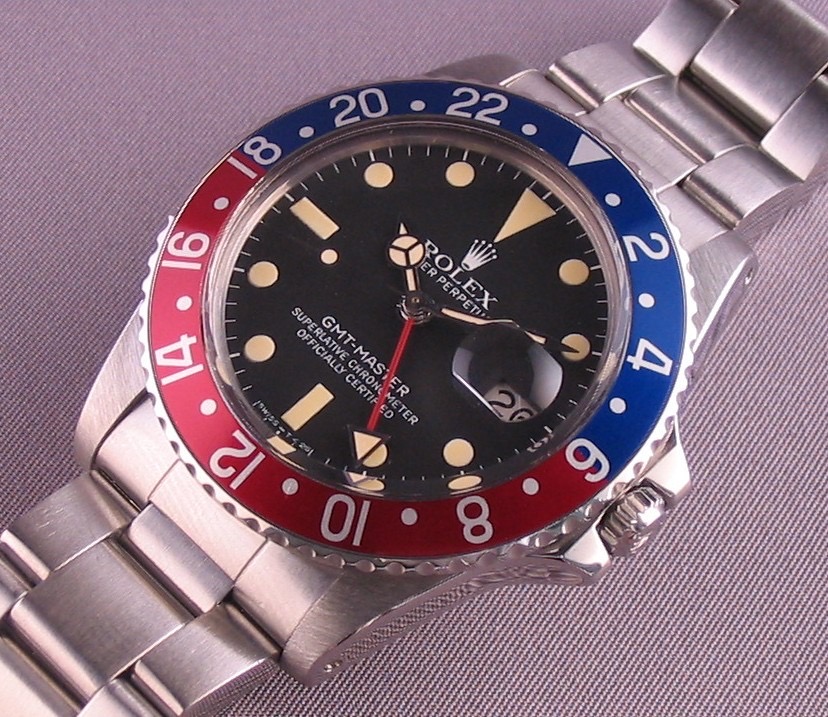
Photo courtesy of mike950
Introduced in 1980 to replace the ref. 1675, the new GMT was virtually identical
to its illustrious predecessor, with its familiar choice of blue/red “Pepsi” or
black bezel inserts, matte dial & acrylic crystal (although somehow the watch
was now depth rated to 100 meters of water resistance, up from 50m on the 1675).
But beneath the hood, the 16750 sported a new cal. 3075 movement with a 28.8k
bph rate (as compared to 19.8k for the previous cal. 1575) & the convenient
quickset date feature.
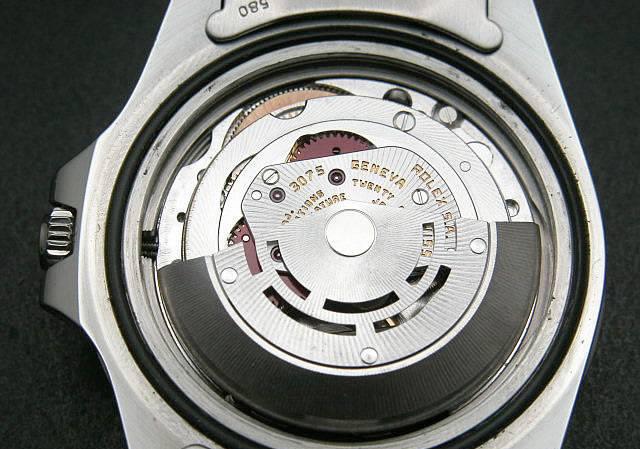
Photo courtesy of Clifton
Interestingly, while the stainless steel and two-tone (16753) models both
retained the familiar acrylic crystal, the solid gold version (16758) featured a
synthetic sapphire crystal like those mounted on the new generation of Sub &
Sea-Dweller as a kind of “deluxe” bonus feature.

Brochure photo courtesy of Wolfgang
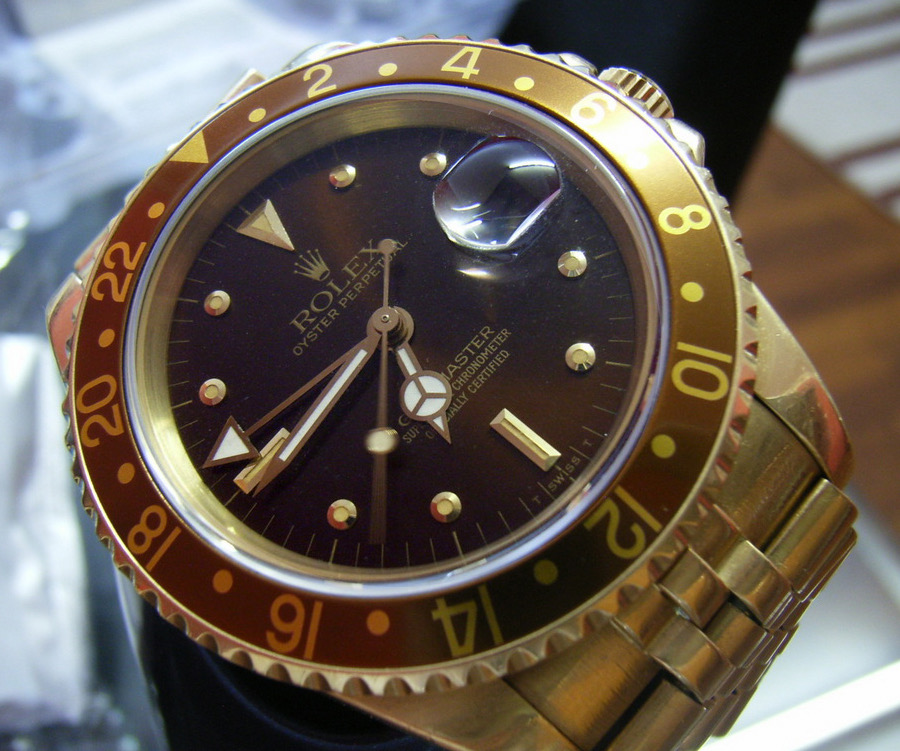
Photo courtesy of John the
crocodileman
Eventually during the course of 16750 production, as it had with the
transitional Sub & ‘Dweller, Rolex switched to a glossy dial with white gold
surrounds (around 1985). Additionally, glossy dials frequently replaced matte
dials when the watch was sent in for service. Therefore, finding a 16750 with
its original matte dial is somewhat rare today. One interesting dial
characteristic that the matte 16750s seem to share is the exceptionally
tall/elongated coronet.

Photo courtesy of Tim/cargoeng
Ref. 16760
In 1983, Rolex introduced the revolutionary GMT-Master II, the original version
of which bore reference 16760.

At last delivering on the logical next step for a multi-time zone watch, the
16760 featured the new cal. 3085 movement, which de-linked the hour hand from
the large triangle 24-hour hand for instantaneous setting of the second time
zone on the face of the watch itself (the quickset date was sacrificed for this
exciting feature).

Further, the seconds hand only hacked when the crown was pulled all the way out
to the standard time-setting position, while it continued running when merely
setting the hour hand to the new destination time. This enabled the GMT-Master
II to maintain the legendary Rolex accuracy without interruption while
traversing the globe. And now, since home time & local time could be read
simultaneously on the face of the watch, the rotating bezel could be used to
calculate a third time zone if needed.
But the movement was not the only new feature on the 16760. The watch was also
the first GMT to be produced exclusively with a sapphire crystal. The rotating
bezel, while remaining bi-directional of course, now had a ratcheting action.
Interestingly, the only bezel insert offered on the original GMT-II was a new
color combination of black & red. The 16760 was never offered in gold or steel &
gold and was always fitted with a gloss/WG surround dial.
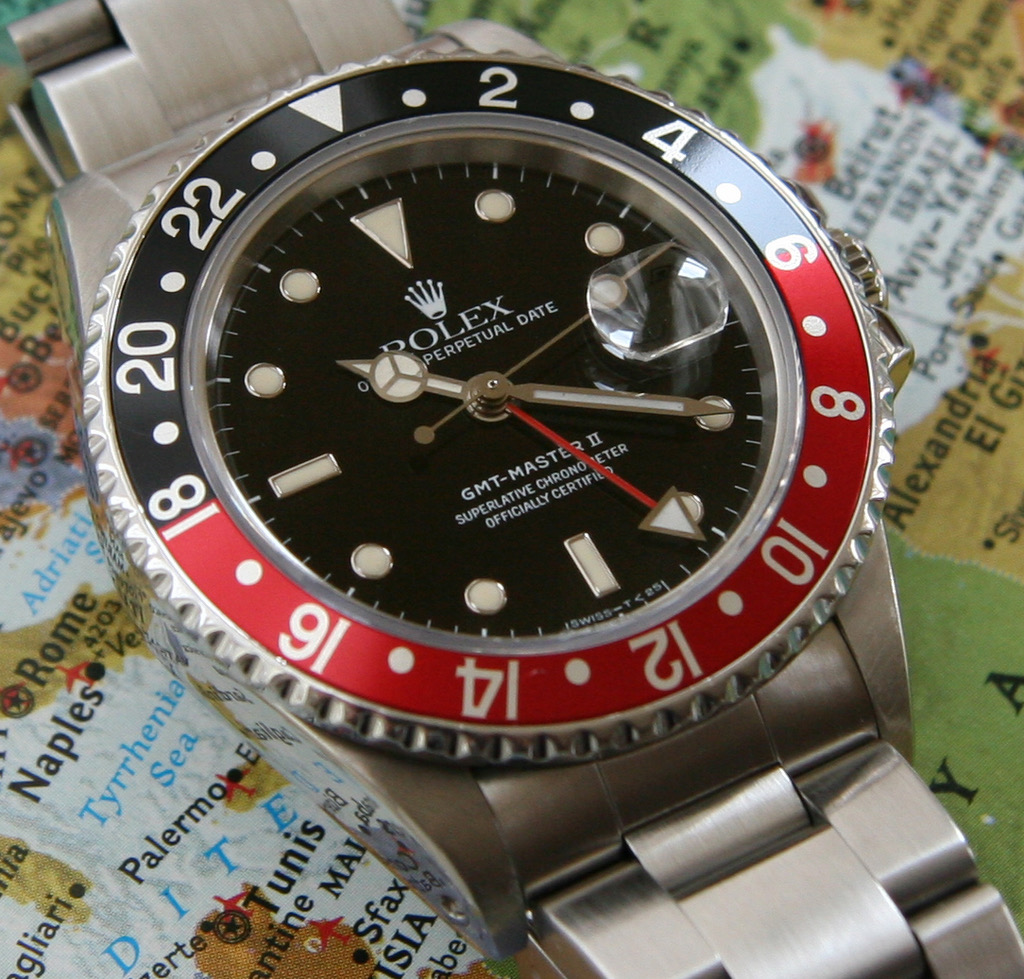
Even more interestingly, the 16760 GMT-II boasted an extra-thick case, some .5mm
thicker than its predecessor, as well as a thicker bezel & crown guards. This
has led to the affectionate nicknames “Fat Lady” and “Sophia Loren” in a nod to
the 16760’s zaftig proportions. One can see in this comparison with the 16660
Sea-Dweller just how thick the original GMT-II’s case actually was:

Produced only until 1988, the short-run 16760 was replaced by the much longer
running ref. 16710 GMT-Master II. Not only did the 16710 sport a new caliber of
movement (the identically functioning cal. 3185), but it had also lost weight
and returned to more slender, GMT-like dimensions.
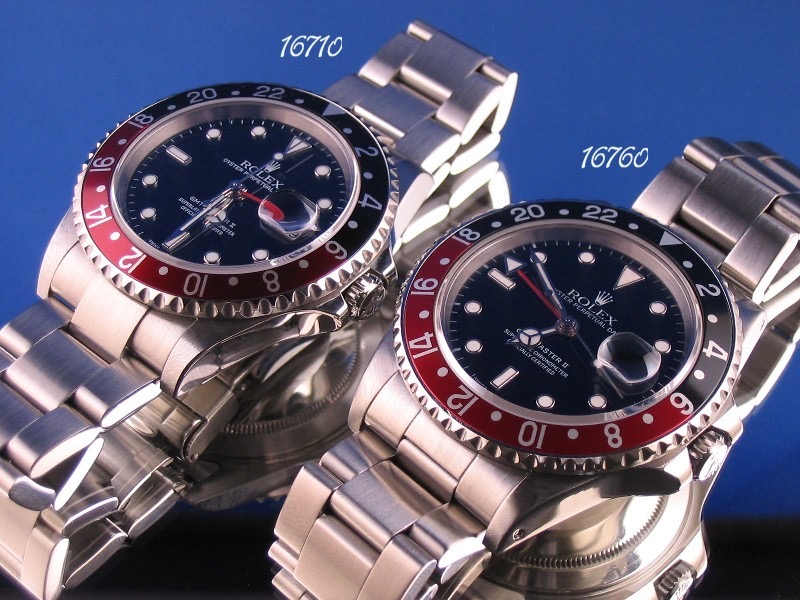
photo courtesy of mike950
(Rumor has it that the stalwart ref. 16710 may itself soon be replaced in 2007
by the gigantic, ceramic bezel 116710 GMT-II in Stainless Steel.)
Ref. 16700
In a somewhat puzzling move, Rolex decided not to designate the GMT-Master II
and its revolutionary innovations as the exclusive representative of the GMT
line. Rather, they retained and transformed the old non-independent hour hand
version with a new case, sapphire crystal, ratcheting bezel and gloss/WG
surround dial.

Photo courtesy of Alun
Introduced circa 1988, the ref. 16700 replaced the ref. 16750 in the Rolex
catalog while remaining less expensive than it’s more evolved sibling, the
GMT-II. Featuring the updated cal. 3175 (which functioned identically to the
previous cal. 3075), the 16700 was sold until the remarkably late date of 1999,
although overall production seems relatively small in comparison to the more
advanced & functional 16710 GMT-II. Also, it appears that the 16700 was only
offered with the Pepsi bezel insert but there is some information that shows that the black insert was also availalble and to distinguish it from the GMT-II (though
it’s certain changes to the insert could be made on customer request).

Photo courtesy of Alun
The ref. 16700 was also only available in Stainless Steel.
There are some claims of matte-dialed 16700s, but due to the late date of the
introduction of the reference—ca.1988--by which time the entire Rolex Sports
line had converted to gloss/WG dials, this must be considered extremely rare at
best and not particularly believable at worst.
The Future & the Past
As the long running “modern” 16710 GMT-II prepares to be replaced in the
inevitable Rolex evolution by the “bigger, better” 116710 LN, it pays to
remember that for Rolex, the only constant is change. If one needed any proof of
that maxim, simply look back to the 1980s when, in replacing the 1675 as
virtually the sole standard bearer of the line from 1959 to 1980, Rolex rolled
out a remarkable 4 references of GMT--truly a time of transition for the
GMT-Master.
Acknowledgments: Many thanks to
Werner/Gatsby & Oskar/O.E., Tim/cargoeng & John/fatboyharris for lending their
technical expertise and Rolex knowledge to this article and thanks to all who
contributed their photos—it is much appreciated! tomvox1
